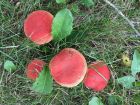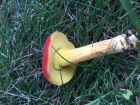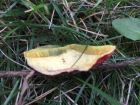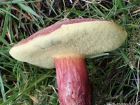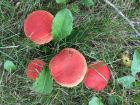Cap convex, becoming broadly convex or nearly flat in age, scarlet to raspberry red when young, with a dry velvety texture. The extreme margin often has a pale yellow or white band around it, and it discolours darker, and dirtier with age. Pores small, pale yellow, become greenish with age and bruise slowly. Stem slender and long, cylindrical, bright yellow at the apex, and progressively more red towards the base. Spore print olive-brown.
Synonyms: Hortiboletus rubellus and Xerocomellus rubellus refer to the same species.
Similar species include Hortiboletus Simonini.
Microscopic Features: The spores are subfusiform to subellipsoidal in shape and have a smooth surface. They measure approximately 11.5-12.5 x 5-5.5µm.
Hortiboletus rubellus on the www.first-nature.com web site.
Xerocomellus rubellus on the MushroomExpert.Com Web site.
Many mushrooms are poisonous, and some can be lethally toxic. Distinguishing between edible and poisonous mushrooms can be very challenging. Therefore, we strongly advise against consuming wild mushrooms. This website does not contain any information about the edibility or toxicity of mushrooms.
Although efforts have been made to ensure accuracy on this website, the information may contain errors and omissions. Therefore, all content provided is for educational and informational purposes only and should not be relied upon or used as a basis for consuming any plants or mushrooms.
External links are provided for reference only. We do not endorse or take responsibility for the content, advice, or products found on these sites or in any advertisements shown on this website.
